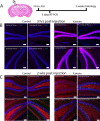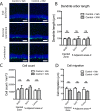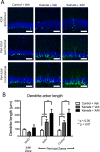Neuronal network remodeling and Wnt pathway dysregulation in the intra-hippocampal kainate mouse model of temporal lobe epilepsy
- PMID: 31596871
- PMCID: PMC6785072
- DOI: 10.1371/journal.pone.0215789
Neuronal network remodeling and Wnt pathway dysregulation in the intra-hippocampal kainate mouse model of temporal lobe epilepsy
Abstract
Mouse models of mesial temporal lobe epilepsy recapitulate aspects of human epilepsy, which is characterized by neuronal network remodeling in the hippocampal dentate gyrus. Observational studies suggest that this remodeling is associated with altered Wnt pathway signaling, although this has not been experimentally examined. We used the well-characterized mouse intrahippocampal kainate model of temporal lobe epilepsy to examine associations between hippocampal neurogenesis and altered Wnt signaling after seizure induction. Tissue was analyzed using immunohistochemistry and confocal microscopy, and gene expression analysis was performed by RT-qPCR on RNA extracted from anatomically micro-dissected dentate gyri. Seizures increased neurogenesis and dendritic arborization of newborn hippocampal dentate granule cells in peri-ictal regions, and decreased neurogenesis in the ictal zone, 2-weeks after kainate injection. Interestingly, administration of the novel canonical Wnt pathway inhibitor XAV939 daily for 2-weeks after kainate injection further increased dendritic arborization in peri-ictal regions after seizure, without an effect on baseline neurogenesis in control animals. Transcriptome analysis of dentate gyri demonstrated significant canonical Wnt gene dysregulation in kainate-injected mice across all regions for Wnt3, 5a and 9a. Intriguingly, certain Wnt genes demonstrated differential patterns of dysregulation between the ictal and peri-ictal zones, most notably Wnt5B, 7B and DKK-1. Together, these results demonstrate regional variation in Wnt pathway dysregulation early after seizure induction, and surprisingly, suggest that some Wnt-mediated effects might actually temper aberrant neurogenesis after seizures. The Wnt pathway may therefore provide suitable targets for novel therapies that prevent network remodeling and the development of epileptic foci in high-risk patients.
Conflict of interest statement
The authors have declared that no competing interests exist.
Figures






Similar articles
-
Canonical Wnt activator Chir99021 prevents epileptogenesis in the intrahippocampal kainate mouse model of temporal lobe epilepsy.Exp Neurol. 2024 Jun;376:114767. doi: 10.1016/j.expneurol.2024.114767. Epub 2024 Mar 22. Exp Neurol. 2024. PMID: 38522659 Free PMC article.
-
Induction of the Wnt inhibitor, Dickkopf-1, is associated with neurodegeneration related to temporal lobe epilepsy.Epilepsia. 2007 Apr;48(4):694-705. doi: 10.1111/j.1528-1167.2007.01055.x. Epilepsia. 2007. PMID: 17437412
-
Wnt/β-catenin signalling pathway mediated aberrant hippocampal neurogenesis in kainic acid-induced epilepsy.Cell Biochem Funct. 2017 Oct;35(7):472-476. doi: 10.1002/cbf.3306. Epub 2017 Oct 19. Cell Biochem Funct. 2017. PMID: 29052243
-
The Role of Wnt/β-Catenin Signaling Pathway in Disrupted Hippocampal Neurogenesis of Temporal Lobe Epilepsy: A Potential Therapeutic Target?Neurochem Res. 2015 Jul;40(7):1319-32. doi: 10.1007/s11064-015-1614-1. Epub 2015 May 27. Neurochem Res. 2015. PMID: 26012365 Review.
-
[Changes in spontaneous epileptic activity after selective intrahippocampal transection in a model of chronic mesial temporal lobe epilepsy].Neurochirurgie. 2008 May;54(3):135-40. doi: 10.1016/j.neuchi.2008.02.002. Epub 2008 Apr 15. Neurochirurgie. 2008. PMID: 18417168 Review. French.
Cited by
-
Low-intensity exercise combined with sodium valproate attenuates kainic acid-induced seizures and associated co-morbidities by inhibiting NF-κB signaling in mice.Front Neurol. 2022 Sep 21;13:993405. doi: 10.3389/fneur.2022.993405. eCollection 2022. Front Neurol. 2022. PMID: 36212646 Free PMC article.
-
Canonical Wnt activator Chir99021 prevents epileptogenesis in the intrahippocampal kainate mouse model of temporal lobe epilepsy.Exp Neurol. 2024 Jun;376:114767. doi: 10.1016/j.expneurol.2024.114767. Epub 2024 Mar 22. Exp Neurol. 2024. PMID: 38522659 Free PMC article.
-
A Warburg-like metabolic program coordinates Wnt, AMPK, and mTOR signaling pathways in epileptogenesis.PLoS One. 2021 Aug 6;16(8):e0252282. doi: 10.1371/journal.pone.0252282. eCollection 2021. PLoS One. 2021. PMID: 34358226 Free PMC article.
-
Research progress of connexins in epileptogensis.Acta Epileptol. 2025 Mar 15;7(1):14. doi: 10.1186/s42494-025-00203-9. Acta Epileptol. 2025. PMID: 40217413 Free PMC article. Review.
-
Wnt Signaling Modulators Exhibit Neuroprotective Effects via Combating Astrogliosis and Balancing Synaptic Density at Early and Late Stage Temporal Lobe Epilepsy.Neurochem Res. 2024 Nov;49(11):3156-3175. doi: 10.1007/s11064-024-04236-3. Epub 2024 Sep 5. Neurochem Res. 2024. PMID: 39235578
References
Publication types
MeSH terms
Substances
Grants and funding
LinkOut - more resources
Full Text Sources

